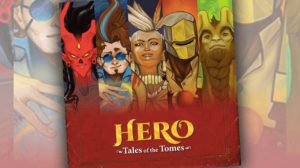Disclaimer: The photos used in this review are based on an older edition and does not represent the announced reprint edition.
2012. That’s when this game was released, so why am I reviewing this in the glorious year 2020? Because the boys and girls at Gale Force Nine have announced a reprint of this game. The major difference is the aesthetics since the original game was using photos based on the Starz TV show and the reprint uses custom artwork. To say the least, the feelings towards this visual change have been mixed.
However, based on the limited information out there, everything else seems to be intact. The card text and abilities in the reprint are copied from the original version, word for word. I’ve managed to grab a copy of the original game at a stupidly low price, and I also purchased the first expansion at an inflated price which required me to drive an hour in one of the most dangerous thunderstorms in Ontario to grab it. Mid-life crisis takes on the strangest forms.
Enough about the history of the game or my personal experience, let’s talk about the game itself.
You are insignificant and that is going to change. You and three other players are heads of a Dominus with each Dominius having their own powerful ability to earn Influence. This road to untouchable clout will be littered with politics, deals, slaves, and gladiatorial combat. You want to reach 12 Influence before anyone else, and that is going to take about 2 to 3 hours.

Flow Like Wine
Each round of the game consists of four phases: Upkeep, Intrigue, Market, and Arena. Everyone participates in each phase, allowing everyone to engage with very little downtime. Despite the potential 3 hour length, it keeps everyone’s attention, which is a rarity in these types of games.
The Upkeep is as simple as it sounds. Everyone refreshes any used cards from the previous round, check to see if any Injured Slaves or Gladiators die painfully, and then check to see if you have enough coin to maintain your gladiators. That’s it. Let’s move on.
Intrigue is the politics of the game. Everyone will draw cards from the Intrigue deck, and this deck consists of Schemes, Reactions, and Guards. Guards give you a 50% chance of stopping a hostile Scheme, and Reactions are played out of turn depending on certain conditions. The Scheme cards are where the cracks begin to show.
Schemes are “Take that” cards, either giving you or another player a benefit such as gaining Influence or making someone lose something. Even back in 2012, this was barely considered good game design. To make matters worse, it transforms this game into a predictable affair because any leading player becomes a target of hostile Schemes. While one can argue that Guards prevent these hostile situations, Guards are randomly drawn with a 50% chance of successfully foiling a scheme, so it’s unreliable.
The carrot on the stick is how you play these cards. Every Scheme card has a specific Influence requirement you need to have to play it. If you come across a powerful Scheme card, it will require a high amount of Influence to play. So what if you don’t have enough? You can collaborate with other players by adding their influence with yours to execute the scheme. Best of all, you don’t have to tell the truth of what card you are playing or even show your card until you play it. Gold is something that can be exchanged at any point in the game (“The Golden Rule”) and you can use that to your advantage during this phase.

As you might have guessed, this is where temporary promises and politics happen. Even though the outcome of these cards is creatively bankrupt, the journey to use these schemes is where the Intrigue phase flexes its strength. You can collaborate with a friend to get some gold due to a profitable scheme or send some poisoned wine to your rival’s champion in an attempt to kill them. Small touches like that create this player-driven narrative atmosphere, something that isn’t practiced enough with today’s games.
After Intrigue, the Market phase becomes the center of attention. The first part of this phase is the Open Market, and like the Intrigue phase, you will continue to make deals. Instead of dealing with Schemes, you are now bartering with your assets such as gold, guards, equipment, slaves, and gladiators. Anything can be traded for anything else. You can also make future promises but these ‘favors’ are not binding.
Bidding On Nasty Business
Once that is taken care of, it is time for Auctions. You will have several Market cards face down in a row, and you will reveal one of them face up. The Market deck consists of slaves, equipment, and gladiators. After a glance at the card, everyone will bid at the same time using closed fists. Whoever bid the most coins wins the card, and the next card is revealed.
Very few auction games give this amount of tension. Not revealing everything at once and forcing the closed-fist provides this sense of ambiguity. Obvious solutions to problems are boring, and this auction system will never provide you with a good answer.
After all of the items have been auctioned, you must now bid for the Host. There are many reasons why you might want to be the Host since it is more than a glorified title for “First Player”
Once a Host has been selected, we stride into the Arena phase and this is where we witness the good and the bad. The first thing that happens is the Host will immediately gain 1 influence. The Host must then pick two houses to invite to the arena, and they can invite themselves. The “Golden Rule” applies here so you could try to extort money for an invitation. Once the invitations have been accepted, everyone will place their bets on who will win and how it will end. Yes, there are several ways a match can end such as injury or decapitation.
Now let’s get to the bad. Let’s get into Combat.
Rolling Through The Pain
Every combatant will have a set of three stats. You have your speed, attack, and defense. The number represents how many dice you roll, and this is a “higher is better” type of game. For each point of damage you receive, you must reduce your dice by that amount. As the match progresses, your combatant deteriorates as their dice pool gets smaller and smaller. They aren’t hitting as hard, blocking as well, or moving as fast as they did at the start of the fight.
That’s thematic and brilliant. This isn’t the problem. Initiative is the problem.
At the start of every combat round, you will roll your speed dice and add everything together. If your number is higher than your opponent, you have initiative and can choose who goes first in the combat round. Not only that, but the number of speed dice you have is the number of spaces you can move in the hexagonal arena.
This is a huge problem because even if you have one less die than your opponent, the chances of you winning initiative are quite low. If you have 2 dice and your opponent has 3, they can roll 3-18 and you can only roll a 2-12. The average result of 2 dice is 7 while 3 dice is 10.5. Why is this an issue?

By controlling initiative, you dominate the pace of the match in a powerful way. You can constantly hit your opponent and move out of range for them to hit you back in every single round. This leads to a very predictable match, a description that should not be used in a game involving gladiatorial combat and betting.
An easy fix for this is to make the arena smaller so movement doesn’t play a major role in the victory but still has some influence in the fight. At the time of this writing, there are no images or promo material showing the arena size in the reprinted edition. There is one option and it goes into a grey area for me as a reviewer: House rules.
There is a famous house rule called “Speed Dice Variant” and it fixes the problem. Instead of adding all the Speed Dice together, you compare the highest dice, and if one side is higher, they won Initiative. If there is a tie, then you compare the second highest dice, and so forth. This variant still makes Speed an important stat, but it downplays their influence in the fight. It makes matches unpredictable, which is what you want in this type of game.
That was a bit of a detour, so let’s get back on track here. After a gladiator is defeated in the arena, the host makes a decision. Assuming the gladiator still has their head attached, the Host can decide on whether or not the defeated gladiator lives with the classic “Thumbs Up, Thumbs Down” method. This is where the Host can be “diplomatic” with bribes and promises.
And that’s the entire round. My thoughts?
Somewhat Holding Up
Very few board games, today and back then, barely have mechanisms that associate themselves well with their theme. Spartacus is still a living example of a game chaining its rules to its visuals extremely well. A hallmark of a great game isn’t what you did during the game, but what you talk about after the game with your friends, and this red box is going to give you plenty of stories to laugh about.
No fan of Spartacus is going to say this game is deep or strategic. It’s a stupid and violent game done right. It still has light yet interesting decisions and plenty of interaction armed with reasonable pacing. Downtime is a myth here because every phase involves someone dealing with someone else in one form or another. This is one of the few games where the 2 to 3 hour time frame isn’t a hindrance because everyone is invested in every single step. Don’t expect a game that plays like it was crafted in a lab full of German mathematicians though.
There are some wrinkles in this glorious Roman cloth though. The Intrigue phase will be a frustrating experience for any skillful player due to “take that” Scheme cards. In terms of balance, House Glaber’s power is considered to be the best out of the four available Houses. As mentioned previously, the Arena phase is heavily dominated by the speed dice where it feels two fighters are just chasing each other instead of fighting it out. You would think a reprint of an 8-year-old game would make some adjustments but the promo images of the reprint show us that it isn’t the case.
However, any perceived views of overpowered cards or powers such as my own are ratified by the game’s mechanisms. Due to the open nature of negotiation, players that appear to be in a powerful position can easily be neglected through careful diplomacy by the weaker players. It is a game that forces you to manage money, bidding, diplomacy, and tactical combat in one tight package.
Even though this is an older game, I can’t help but respect what it brings to tabletop gaming. Yet despite what I said, I can’t fully recommend this. This is a niche game within a niche hobby coddling to a specific audience. There are plenty of random elements, and any notion of clever plays can easily be thwarted by card draws or dice rolls. Backstabbing is such an exploitable tactic that the rule book has a section on not being a dick to your friends. If you have any doubts about what you’ve read so far, there is a legitimate reason for it. However, if the negatives points I bought up barely faze you, then this future reprint could be worth pursuing.











Add Comment